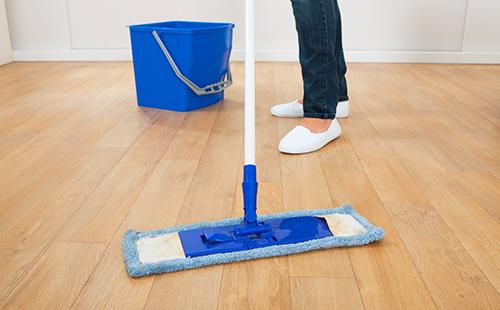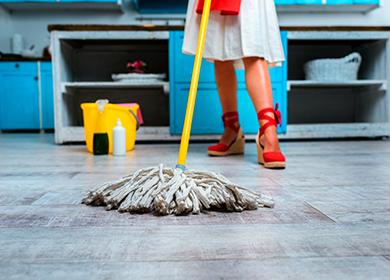The content of the article
You will be surprised, but the cleaning companies generally recommend cleaning floors in the apartment no more often than ... two or three times a year! Just “washing” and “wet cleaning”, as it turns out, are two different concepts. In the second case, the procedure is carried out regularly. But general cleaning of the floor covering with the use of additional detergents should not be frequent so as not to damage the surface.
Optimal frequency
If we talk about the frequency of wet cleaning in the house, then there are no established standards, such as in a hospital, where you need to wash the rooms two to three times a day. In the apartment it all depends on the type of flooring, the composition and lifestyle of the family, the time of year. For example, in a house with linoleum, where two working adults and a schoolchild live, you need to wash the floors:
- summer - in one day;
- in winter - few times a week.
Required Inventory
Before you start cleaning floors, you need to prepare the room, equipment and set up for cleaning. We will need:
- rags;
- mop;
- bucket;
- brush;
- rubber gloves;
- liquid for mopping.
Where to begin
Before you start cleaning, change into a "home". Your "uniform" should be soft, practical and not constraining movement. Wipe the sole of the slippers so that you do not leave dusty traces on a clean surface. Further:
- air the rooms - and also remove dusty deposits from furniture and carpets;
- free up space - you should roll up and remove the carpets, lift chairs, floor vases, lamps and other oversized interior items;
- wipe the legs - it is these pieces of furniture that “catch” dust, hair, and dirt;
- remove the trash - wet broom or vacuum cleaner.
How to clean floors: the subtleties of wet cleaning
After the preparatory phase is completed, visually divide the floor into small sections and proceed:
- use detergents - special liquids for mopping like Pronto or Mr. Proper make it easy to cope with impurities and leave a pleasant aroma;
- start with hard to reach places - mop under the bed, wardrobe, table;
- move from the window - towards the door, so as not to trample the washed areas;
- wash to clean water - wipe the floor until the water becomes clear;
- change water often - immediately, as soon as she became slightly cloudy;
- wipe dry - Use a dry cloth to remove any moisture so that there are no stains and the coating does not deform;
- wash rags, nozzles, brushes - also wash the bucket, and send the equipment to dry on the balcony before the next cleaning.
Mop or hands
It doesn’t matter how you decide to wash the floor - with a mop or with your hands - you need to follow the rules described above. The result in both cases will be achieved. But how to work more conveniently? Is it realistic to wash floors manually without stains? Here you decide for yourself, focusing on the pros and cons described in the table.
Table - Features of mopping and manual mopping
| How to clean floors | pros | Minuses |
|---|---|---|
| Hands | - Useful for a figure (more calories are burned); - no need to splurge on a mop and nozzles to it; - it is convenient to wash skirting boards and corners; - the result seems to be better; - heavy dirt can only be removed manually | - It takes more time; - it is difficult to process hard-to-reach places under furniture; - it is inconvenient to work with gloves, and without them the manicure deteriorates; - there is a load on the back, arms and knees |
| Mop | - Cleaning is faster; - no load on the back, arms and knees; - conveniently handle the floor under the furniture; - hygienic; - if the squeegee is automatically squeezed, hands are not exposed to detergents | - A good mop is expensive; - Skirting boards, corners and stubborn spots still have to be processed manually; - if you just need to quickly refresh “prominent places”, it’s more difficult to tack between carpets and furniture with a mop |

Folk remedies for different floorings
The territory of a modern house is not always limited to one type of flooring. Often, the floors in the bedroom are covered with one material, in the kitchen with another, and in the bathroom with a third. Modern housewives know how to quickly clean the floors in an apartment, regardless of their type, using both modern and folk remedies. Especially relevant are such methods when the “generalka” is coming up, and it is necessary to wash the coating from complex contaminants. As cleaning agents, you can come in handy:
- powder (washing, cleaning);
- soap (household, liquid);
- ammonia;
- vinegar (citric acid);
- salt;
- glycerol;
- turpentine;
- mastic.
Boardwalk unpainted floor
Features. This is an environmentally friendly coating. The floor is wooden and is called unpainted because of its external characteristics. Although, in fact, the boards are always treated with oil, varnish or wax. This, in fact, is also a kind of paint, only colorless, due to which the bars retain their natural appearance. Remove stubborn stains from this floor in the following way.
What to do
- Dilute two tablespoons of soap shavings in 6 liters of warm water.
- To process the floor with the resulting solution using a brush with hard bristles.
- Pour vinegar into clean cold water: two tablespoons per 6 liters of water.
- Wash the floor with acidified water using a soft cloth.
- Wipe dry.
Plank painted floor
Features. He is not afraid of water. If the paint is good, it will not peel even under the influence of strong detergents. It is easy to remove dirt from such a coating. The only thing you need is to make sure that the boards are shiny. The ammonia will help here.
What to do
- In 6 liters of cold water, dilute two tablespoons of ammonia.
- Wash the floor with the resulting solution.
- Additionally, rinse the solution is not necessary.
Parquet and laminate
Features. Parquet and laminate are considered the most capricious types of flooring. For cleaning do not use abrasive cleaners, steam cleaners. Do not allow moisture to enter the crevices; this contributes to swelling of the floor. Allowed the use of purchased funds such as "Denkmit". This product contains wax, gently cares for the coating, protects it from the effects of UV rays and premature wear. If you do not use special care products, then remember: it is better not to wet such a floor. Just vacuum it well, wipe it with a damp cloth and thoroughly remove any remaining moisture by rubbing it with a dry flannel until it shines. And you can get rid of persistent stains on the floor with washing powder.
What to do
- From one tablespoon of washing powder and a small amount of water, “knead” the pulp.
- Apply to stain, leave overnight.
- Rinse with warm water in the morning.

Tile and ceramic tile
Features. The most unpretentious floor is tiled. It is easy to wash, clean from dirt, dust and stains. A smooth, glossy surface is washed as follows.
What to do
- In a bucket of water, dilute four to five drops of ammonia.
- Optionally and if available add a tablespoon of glitter for dishwashers.
- Wash the floor with the resulting solution.
- Wipe dry.
Linoleum
Features. Linoleum is not resistant to ammonia, soda powder, hot water, bleach and hard brushes. It is necessary to wash the linoleum coating quickly, otherwise the pattern may suffer.
What to do
- In 6 l of water, dissolve two tablespoons of soap chips.
- Wash the floor with the resulting solution.
- From above, immediately walk with clean cool water, not allowing the soap to dry.
- If the linoleum is smooth, moisten a soft cloth in linseed oil and grate the floor.
Carpet
Features. This is a coating that does not tolerate wet cleaning. It is best to clean it with special dry foam, using a vacuum cleaner for subsequent removal of the product. Or use carpet cleaners. You can also use a washing vacuum cleaner or steam cleaner. In winter, the carpet, if it is possible to dismantle, is cleaned in the snow. But how to wash stubborn stains?
What to do
- Mix three large spoons of medical alcohol with a spoon of vinegar.
- Moisten the stain and leave for half an hour.
- Remove the solution with a sponge.
Universal methods from stubborn stains
Having remembered several universal tricks, you can easily cope with spots of any complexity on all types of coverage.
- Mud. The easiest way to wash it off is with detergent or dishwashing detergent like Fairy.
- Fat. To clean greasy deposits from the floor, mix baking soda and sunflower oil to a thick sour cream consistency. Rub the floor with the mixture, let stand for 10-15 minutes. And then - sweep away the remaining soda with a broom and wash it with cold water.
- Mold. It can be defeated by washing floors with bleach. The use of bleach requires proportions, the use of protective equipment and the mandatory ventilation of the room. 10 g of bleach is added to 5 l of water. The floor is washed with open windows when there are no children or animals in the house.
Post-repair processing
The most difficult thing is to wash the repair marks off the floors. Marks from whitewash, putty, glue and paint remain on them. Before cleaning floors after repair, stains must be removed.
- Paint and glue. They are best removed with acetone or white spirit. If the glue is wallpaper, then it is washed off with ordinary thermal water in several passes. Oil paint is easy to remove with Cif cream. If linoleum is stained, try wiping the stain with vegetable oil. Fresh spots from water-based paint can be easily removed with a soap solution. If the "blots" are old, and the coating tolerates moisture, moisten it with soapy water and leave for 15-20 minutes. Formic acid or isopropyl alcohol will also remove stains after painting without much effort without damaging the floor surface.
- Frozen putty and lime. First, gently remove the coating with a spatula, and then rinse off the residue with hot water and vegetable oil. A bucket of liquid needs 100 ml of product. Another effective way to clean the floor from whitewashing is a solution of water with salt (100 g of spice in 5 l of water).
After the stains have receded, wash the floors clean in the usual way, taking into account the type of coating.

When to wash - morning or evening
It is interesting that the old Slavic traditions and signs, like Feng Shui, endow the process of mopping with a certain symbolism. For example, it is believed that it is impossible to clean in the evening, otherwise the hostess invites evil spirits into the house. And vice versa, if you free the room from garbage and dust during daylight hours, a woman lets prosperity, prosperity, positive energy into her home. They also say that you can not wash the floor of pregnant women, otherwise you can provoke premature birth.
But real life dictates its conditions. In the afternoon, women usually work, so household chores remain for the evening. And expectant mothers, in order not to get tired, know how to mop the floors clean. And they use “smart” equipment, which even “twists” itself. "Assistants" with telescopic handles (rope, microfiber, spongy) significantly facilitated the life of a modern housewife.

